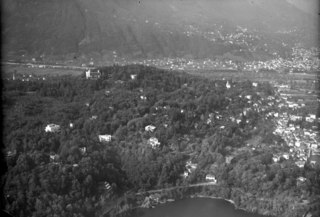
Ticino, sometimes Tessin, officially the Republic and Canton of Ticino or less formally the Canton of Ticino, is one of the 26 cantons forming the Swiss Confederation. It is composed of eight districts and its capital city is Bellinzona. It is also traditionally divided into the Sopraceneri and the Sottoceneri, respectively north and south of Monte Ceneri. Red and blue are the colours of its flag.

The river Ticino is the most important perennial left-bank tributary of the Po. It has given its name to the Swiss canton through which its upper portion flows.

Locarno is a southern Swiss town and municipality in the district Locarno, located on the northern shore of Lake Maggiore at its northeastern tip in the canton of Ticino at the southern foot of the Swiss Alps. It has a population of about 16,000 (proper), and about 56,000 for the agglomeration of the same name including Ascona besides other municipalities.

Valle Maggia is an alpine valley in the Vallemaggia district of canton of Ticino, the Italian-speaking canton of Switzerland. The valley is formed by the river Maggia and is situated between the Centovalli and Lago Maggiore as well as the Valle Verzasca in the East.

There are 106 municipalities in the canton of Ticino, Switzerland,. Municipalities (comuni) are grouped in circles (circoli) which are part of districts (distretti).

Lake Maggiore or Verbano is a large lake located on the south side of the Alps. It is the second largest lake in Italy and the largest in southern Switzerland. The lake and its shoreline are divided between the Italian regions of Piedmont and Lombardy and the Swiss canton of Ticino. Located halfway between Lake Orta and Lake Lugano, Lake Maggiore extends for about 64 kilometres between Locarno and Arona.

The A13 is a motorway, at times an Autostrasse (expressway), which runs from St. Margrethen in northeastern Switzerland through to Ascona in southern Switzerland, crossing the main chain of the Alps in the Grisons area. It is the southern half of European route E43.

Ascona is a municipality in the district of Locarno in the canton of Ticino in Switzerland.

The Borromean Islands are a group of three small islands and two islets in the Italian part of Lago Maggiore, located in the western arm of the lake, between Verbania to the north and Stresa to the south. Together totalling just 50 acres in area, they are a major local tourist attraction for their picturesque setting.

Brissago, is a municipality in the district of Locarno in the canton of Ticino in Switzerland, bordering Italy. Brissago lies on the western shore of Lake Maggiore and includes the Brissago Islands.

Monte Verità is a 321 metres above sea level high hill and a cultural-historical ensemble in the Swiss canton of Ticino. The site is in the municipality of Ascona, about half a kilometre north-west of the old town. Monte Verità, located on Lake Maggiore, was a well-known meeting place for the life-reformers (Lebensreform), pacifists, artists, writers and supporters of various alternative movements in the first decades of the 20th century. After 1940 the place lost its importance. An attempt at a revival in the late 1970s met with very limited success.

Intragna is a village and locality in the municipality of Centovalli in the district of Locarno of the canton of Ticino in Switzerland.

Palagnedra is a village and a locality part of the municipality of Centovalli in the district of Locarno in the canton of Ticino in Switzerland. Lago di Palagnedra is located below the village, on the Melezza river.

Isola Madre, at 220 m wide and 330 m long, is the largest island of the Isole Borromee archipelago which falls within the Italian part of the Alpine Lake Maggiore, in the Province of Verbano Cusio Ossola, Piedmont. The island is occupied by a number of buildings and architectural structures and is especially well known for its gardens. In the past it was known as Isola di San Vittore and later as Isola Maggiore.
Giovanni Antonio Caldelli (1721-1791) was an Italian-Swiss painter, active in both figure and quadratura painting.
CoEur is a Christian devotional and hiking route in Italy and Switzerland. Its Italian subtitle, Nel cuore dei cammini d'Europa, translates as "In the heart of Europe's paths".

Sonja Bragowa, born Gertrud Elsa Knieser, was a German expressionist dancer, revue dancer and solo dancer.

The Italian Lakes are a group of large lakes lying on the south side of the Alps, in the basin of the river Po and the Mediterranean Sea. As their name suggests, they are essentially located in northern Italy, however, they are also partly located in southern Switzerland. They are all glacial lakes that formed after the retreat of the glaciers at the end of the last ice age. The group is composed of : Lake Orta, Lake Maggiore, Lake Varese, Lake Lugano, Lake Como, Lake Iseo, Lake Idro and Lake Garda. The three largest are all well over 100 km2, they are: Lake Garda, Lake Maggiore and Lake Como.

Max James Emden was a German chemist, wholesale merchant, art collector and from 1926 owner of the Brissago Islands on Lake Maggiore. Some of Emden's properties, including valuable paintings, have been the object of Nazi-era restitution claims. How his legacy has been handled has sparked a debate in Germany about the erasure of information concerning the Nazi era and inspired films about his life.

Casa Monte Tabor is a cultural-historic significant building in Porto Ronco, a district of Ronco sopra Ascona, in the Swiss canton of Ticino. In 1931, writer Erich Maria Remarque (1898–1970) bought the villa and lived there until his death. His wife Paulette Goddard (1910–1990) inherited the property from him. After her death the canton of Ticino confiscated the property, which was owned by different people after that.

























